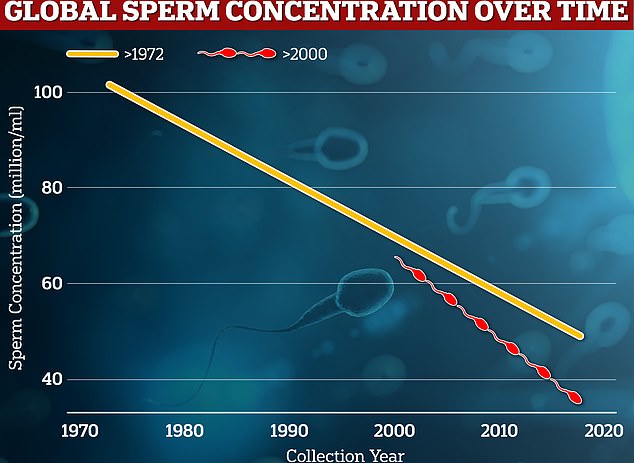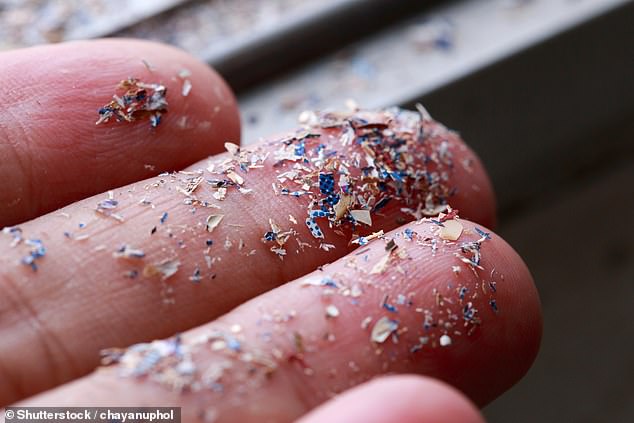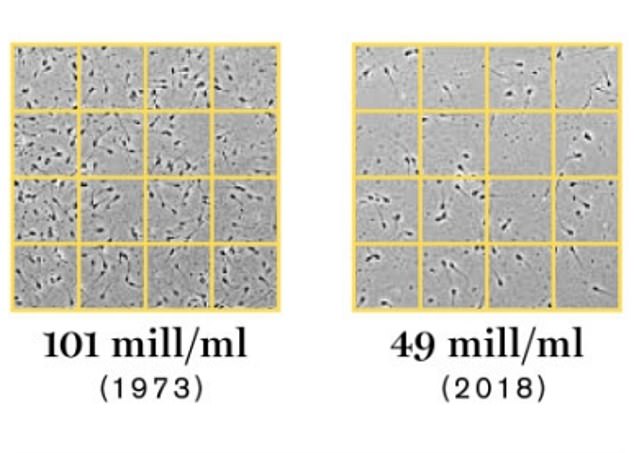Microplastics have been found on the summit of Mount Everest, in the depths of the Pacific Ocean’s Mariana Trench, and now in men’s testicles.
Researchers of the University of New Mexico found 12 types of microplastics in the 23 human testicles studied.
Data has shown that sperm count has decreased by 59 percent in recent decades, and other culprits range from cell phones in pants pockets to vaporizers.
“We don’t want to scare people,” said the study’s lead author. “We want to provide scientific data and raise people’s awareness.”
Microplastics have been found at the top of Mount Everest, in the depths of the Mariana Trench in the Pacific Ocean, and now in the testicular tissue of men. The researchers found 12 types of microplastics in 23 human testicles, suggesting that the small particles could play a role in sperm quality.

The graph shows: The sperm concentration rate is decreasing globally from samples collected between 1972 and 2000 (orange) and since 2000 (red).
The team found that the most prevalent of the 12 microplastics was a polymeric material, polyethylene, used in plastic bags and bottles.
The average human concentration was 329.44 micrograms per gram of tissue, much higher than Recent studies of human blood.which reached only tens of micrograms per gram.
Microplastics, less than five millimeters in length, enter our bodies through plastic packaging, certain foods, tap water and even the air we breathe, and have been linked to cancer and fertility problems.
“There are a lot of microplastics,” said the study’s lead author, Dr. Xiaozhong John Yu. “We can make our own decisions to better avoid exposure, change our lifestyle and change our behavior.”
Dr. Yu was inspired to spearhead the project after a colleague, a professor at the university’s pharmacy school named Matthew Campen, found alarming concentrations of microplastics in human placentas.
The presence of this invisible contamination in placentas, so close to fetuses during pregnancy, Dr. Yu noted, led them both to wonder how else microplastics could be impacting reproduction.
Campen, according to Dr Yu, asked him: ‘Have you considered why there is this decline in reproductive potential more recently? There must be something new.’
Dr. Yu and his team found that the concentration of microplastics in human male testicular tissue was significantly higher than the average Campen found in placental tissue.

In one of the study’s most concerning findings, researchers determined, based on testicular samples from male canines, that the volume of microscopic polyvinyl chloride (PVC) plastic, which is common in pipes, scaled directly to reduce the count. of sperm in dogs.
For ethical reasons, anonymized human male testicular tissue was obtained from the New Mexico Office of the Medical Investigator for the new study.
State forensic examiners collect these tissue materials during autopsies and then storing the frozen material for up to seven years for possible forensic purposes, before they are allowed to legally dispose of it.
The preservation methods used to store human tissue prevented the team from calculating the men’s sperm counts.
To fill this gap, the study also analyzed tissue from dogs, which showed that the volume of microplastics increased directly to reduce sperm count in dogs.
“At first I doubted whether microplastics could penetrate the reproductive system,” Dr. Yu said of his research, published in the journal Toxicological Sciences,
‘When I first received the results for dogs I was surprised. I was even more surprised when I received the results in humans.’

A 2022 report warned that declining sperm counts in men amounted to a global crisis that “could threaten the survival of humanity.” New research this month points the finger at microplastics
Health professionals have been concerned about declining sperm counts in men for years, although the causes appear to be related to multiple environmental factors.
A November 2022 study in the journal Human Reproduction UpdateA review that tabulated data from men in 53 countries found that the average sperm count had plummeted by 51.6 percent between 1973 and 2018 globally.
To analyze their samples, Dr. Yu and his team first chemically dissolved human and canine tissue of organic material, fats and proteins, leaving them with only contaminants, such as microplastics, to study.
Spinning the samples in an ultracentrifuge resulted in separate plastic pellets that could then be identified using traditional laboratory methods such as mass spectrometry.
Dr. Yu explained that the presence of PVC plastic in particular was quite alarming: “PVC can release many chemicals that interfere with spermatogenesis (the creation of sperm in the testicles) and contains chemicals that cause endocrine disruption.”
Disturbances of the endocrine system are known to cause problems with sexual and reproductive hormones in humans, fish, and other species.
The health consequences of microplastics in people have gained more attention in recent years, as studies have shown that the particles appear to contribute to inflammatory bowel disease, pancreatic cancer and Alzheimer’s disease.
Amid growing concerns about microplastics in our bodies and the environment, 175 UN member countries agreed to draw up a plan this year to end plastic pollution: a global plastics treaty.
However, Dr. Yu expressed caution about jumping to conclusions about worst-case scenarios and said he hopes more scientists will study the connections between microplastics and reproductive health.
“We have a lot of unknowns,” he said.
‘We need to really look at what the potential long-term effect (could be). Are microplastics one of the factors contributing to this decrease?


